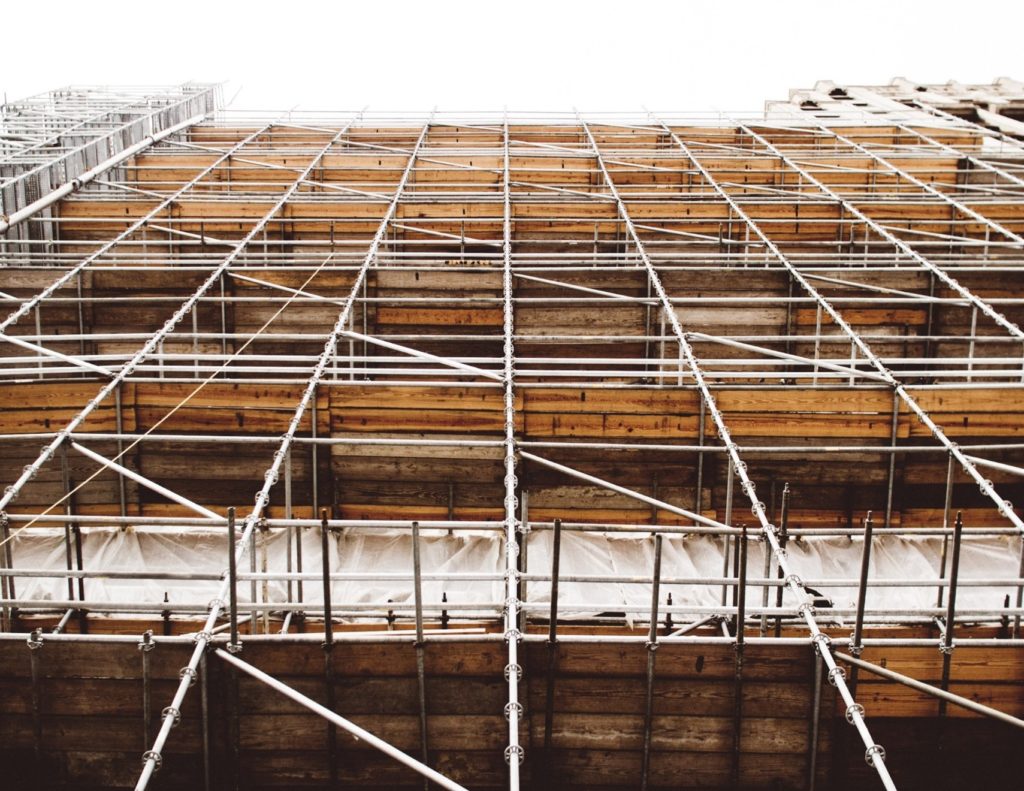
I learned this today. Scaffolding is attached to the building by placing ties through windows, by drilling holes in the brick, or by anchoring them to the ground.
Scaffolding has been used for thousands of years. Sockets have been found in the walls around the cave paintings in the Lascaux cave network. These paintings are 17,000 years old and it suggests that paleolithic people used scaffolding. The Egyptians and Ancient Greeks used scaffolding in their building works. The main theory of how the Egyptians built the pyramids relies on scaffolding to lift and support the heavy blocks. There is a Greek cup called the Berlin Foundry Cup, dated from the 5th century BC, that has an image of scaffolding on it. The ancient Chinese used bamboo scaffolding over 2000 years ago, and they still use it today.
Scaffolding was used in most countries to put up buildings over the centuries, but there were not a huge number of tall buildings. We tend to take tall buildings for granted but, before the invention of the elevator, it would take too much time and energy to go up all of the stairs. In fact, it was only in 1311 that building taller than the Great Pyramid at Giza was built. (Lincoln Cathedral). Scaffolding was made of wooden poles tied together and suspended with rope.
Scaffolding underwent three significant changes in the early 20th century. These were the inventions of the scaffixer and the universal coupler in 1913 and 1919. Both of these allowed pieces of scaffolding to be connected together and they were far stronger and more reliable than rope. The third change was the introduction of tubular steel pipes with standardized dimensions. They were far stronger than wood, lighter, and could be used on any scaffolding because of their standardized size. These three things were so useful that they are still in use today.
There are basically two types of scaffolding structure: free standing and not free standing. As the name implies, free standing scaffolding is supported under its own weight and balanced without support from anything else. It cannot be built very high because of its lack of stability. Generally, it can be built to a height that is four times its width. Free standing scaffolding has to have a very sturdy base and sometimes they use counterweights for balance.
The type of scaffolding that we see against the sides of buildings is not free standing. It has to be anchored to the building it is against or it will either topple over or collapse under its own weight.
So, how is scaffolding anchored to a building? The first method is called “through ties”. The scaffolding is connected to the building by ties that go through openings, such as windows. A horizontal tube is positioned across the open window on the inside and on the outside. Another tube from the main structure is connected to these two tubes. The frame of the opening holds the scaffolding structure in place.
The second method is called “reveal ties”. These are extendible poles that are wedged into an opening in the building, for example a window frame. When they are extended enough to be secure, a pole from the main scaffolding is connected to them.
The third method is called “box ties”. This is used when there is a column or a beam from the building that can be attached to. Two tubes are placed in front and behind the beam. Another two tubes are placed to the left and the right. When all four tubes are connected to each other, they form a sturdy box around the beam and the main scaffolding can be attached to it.
The fourth method is fixed bolt ties. These are probably the most secure. A hole is drilled into the face of the building and an expanding bolt is inserted. The bolt expands, is secured, and then the scaffolding is connected to it. This is the strongest and most reliable tie, but it means drilling holes into the building that need to be repaired as the scaffolding is taken down.
The fifth method is to anchor the scaffolding to the ground. This only works if the scaffolding won’t be too high.
The ties have to be placed about once every 8.5m horizontally and vertically. If the scaffolding also has a sheet to keep out rocks, or just to hide the scaffolding, the ties need to be placed every 4m. This is because the sheet will be pulled by the wind, putting more strain on the scaffolding.
Scaffolding always has to be put up by a professional contractor and it has to be inspected every day before work by a trained person. Scaffolding has to support the weight of all the workers, tools and equipment that are brought onto it. Accidents are fairly common and there are about 4,500 scaffolding injuries a year. 60 of those result in death and 30% of all workplace deaths are due to scaffolding accidents.
So, there are many different ways to anchor scaffolding to a building and this is what I learned today.
Photo by Josh Sorenson: https://www.pexels.com/photo/brown-concrete-building-154141/
Sources:
https://bindleyhardwareco.com/is-scaffolding-attached-to-the-building
https://en.wikipedia.org/wiki/Scaffolding
https://pmixi.com/how-is-scaffolding-attached-to-a-building
https://blog.designsafe.co.uk/common-tie-methods
https://www.unitedscaffold.ca/scaffold-news/does-scaffolding-need-to-be-attached-to-the-building/
https://www.cambridgescaffolding.com/the-history-of-scaffolding
https://en.wikipedia.org/wiki/Berlin_Foundry_Cup
